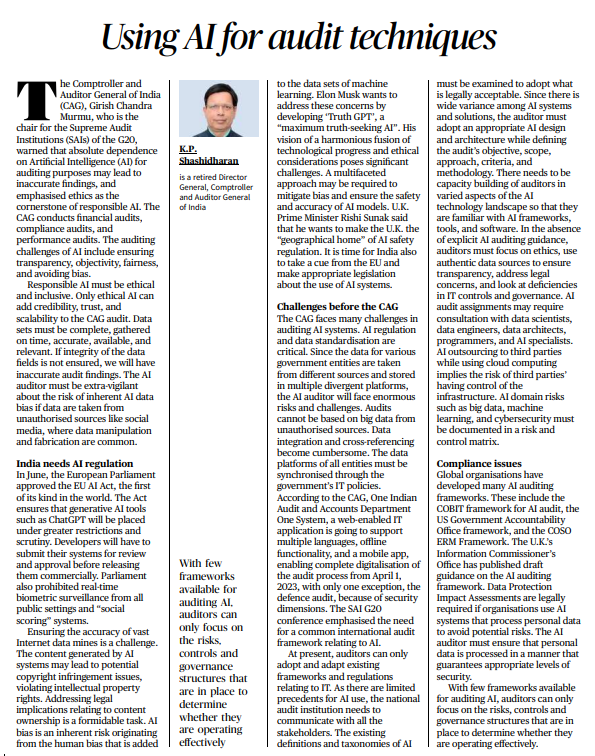Challenges and Imperatives of Auditing Artificial Intelligence: Insights from India's CAG
Introduction:
The Comptroller and Auditor General of India (CAG), Girish Chandra Murmu, who also chairs the Supreme Audit Institutions (SAIs) of the G20, recently issued a warning regarding the increasing dependence on Artificial Intelligence (AI) for auditing purposes.
- The Importance of Ethical AI:
- CAG Murmu underscores the significance of ethics as the cornerstone of responsible AI in auditing.
- Ethical AI ensures credibility, trust, and scalability in the CAG audit process.
- Emphasizes the necessity of complete, accurate, and relevant datasets for AI-driven audits to avoid inaccurate findings.
- Risks of AI Auditing:
- Discusses the challenges faced by AI auditors, including transparency, objectivity, fairness, and bias mitigation.
- Highlights the risk of inherent AI data bias when utilizing unauthorized data sources like social media.
- Stresses the need for addressing legal implications, such as copyright infringement, arising from AI-generated content.
- AI Regulation in India:
- Draws parallels with the EU’s AI Act, emphasizing the need for India to consider similar AI regulations.
- Proposes regulatory measures, such as system review and approval before commercial release and restrictions on biometric surveillance.
- Challenges Before the CAG:
- Addresses the challenges faced by CAG in auditing AI systems, including data standardization and integration.
- Highlights the need for synchronized data platforms among government entities for effective AI auditing.
- Discusses the upcoming web-enabled IT application, ‘One Indian Audit and Accounts Department One System,’ for digitalizing audits.
- International Audit Framework for AI:
- Emphasizes the need for a common international audit framework related to AI, as existing frameworks primarily apply to IT.
- Calls for communication with stakeholders and examination of AI definitions and taxonomies.
- Suggests capacity building for auditors in AI technology, ethics, and legal aspects.
- Compliance Issues:
- Explores global AI auditing frameworks, including COBIT, US GAO, COSO ERM, and the UK’s Information Commissioner’s Office.
- Notes the legal requirement for Data Protection Impact Assessments for AI systems processing personal data.
- Emphasizes the role of auditors in evaluating the effectiveness of risk management controls and governance structures.
Conclusion:
The analysis concludes that AI is becoming increasingly essential in the audit process, but its adoption comes with substantial challenges.
CAG Murmu’s warnings and recommendations highlight the critical need for ethical AI practices, regulation, and capacity building in India’s auditing landscape.
It is imperative that India considers AI auditing guidelines and aligns with international efforts to ensure transparent, unbiased, and effective AI audits.
Circular Migration: A Comprehensive Overview
Introduction
- Circular migration is a recurring pattern of migration where individuals move back and forth between a destination country and their country of origin, driven by the availability of employment opportunities.
- This unique form of migration is prevalent among low-income groups, often seeking seasonal employment in different regions or countries.
- The concept gained recognition in the 1960s and 70s, primarily due to the forces of globalization, improved transportation, communication, and the expansion of multinational corporations. However, it has only recently received proper attention as a distinct migration category.
Defining Circular Migration
- Circular migration can be defined by specific criteria, as outlined by Philippe Fargues.
- These criteria include temporary residence in the destination location, the possibility of multiple entries into the destination country, freedom of movement between the country of origin and the destination country during the period of residence, legal right to stay in the destination country, protection of migrants’ rights, and a demand for temporary labor in the destination country.
- These criteria help differentiate circular migration from other forms of migration.
Quantifying Circular Migration
- A crucial aspect of circular migration is quantifying how many times a migrant must move between countries to be considered a circular migrant.
- According to the United Nations Economic Commission for Europe Task Force, an individual qualifies as a circular migrant after completing at least ‘two loops’ between two countries.
- These loops involve moving from the origin country (A) to the destination country (B) and back to the origin (A). If the migrant repeats this process, moving from A to B to A and then again to B, they have completed two loops and are considered a circular migrant.
- This classification becomes more complex when more than two countries are involved, as each country may categorize the migrant differently based on their movement patterns.
Public Policy Implications
- Public policy plays a crucial role in managing migration, and circular migration offers a unique perspective.
- Migration debates are ongoing worldwide, with concerns ranging from brain drain in origin countries to economic competition and cultural conflicts in destination countries.
- Circular migration is increasingly seen as a balanced approach that considers both the receiving and sending nations’ interests.
- From the perspective of the country of origin, international migration can be beneficial due to remittances sent by migrants, which stimulate the domestic economy.
- However, it can also lead to brain drain as talented individuals leave to pursue opportunities elsewhere. In destination countries, particularly in the West, low-income, low-skill job vacancies have been filled by migrants.
- Still, their influx has created cultural tensions and calls for immigration restrictions.
- Circular migration aims to mitigate these issues by promoting the circulation of labor between countries, alleviating brain drain concerns, and addressing the fears of permanent population growth in host countries.
Circular Migration within India
- In India, internal migration has historically followed a circular pattern. Rural-to-urban migration has surged in response to job opportunities in manufacturing, construction, and services sectors, resulting in rural population decline and urban infrastructure challenges.
- Uneven development post-liberalization has led to inter-state migration, with states like West Bengal, Odisha, and Bihar experiencing high rates of out-migration.
- However, this circular migration within India presents both benefits and challenges. Migrants often secure higher-paying jobs compared to their home states, leading to improved household welfare through remittances.
- Women may gain more autonomy and decision-making power due to the absence of migrating men. Nonetheless, these migrants often face exploitation, language barriers, and precarious working conditions, particularly in southern states.
- They may remain at the margins of society, with limited opportunities for asset creation or savings.
Conclusion and Policy Recommendations
Circular migration is a complex phenomenon that offers potential benefits for both origin and destination countries.
However, its successful implementation requires well-thought-out policies that protect migrants’ rights, address their precarious working conditions, and promote their integration into destination communities.
As circular migration continues to shape the global movement of people, policymakers must strike a balance between economic advancement and social stability, fostering a harmonious coexistence of circular migrants and host populations.
Lessons from the Green Revolution for the Green Transition
Introduction
The recent passing of M.S. Swaminathan, a key figure in India’s Green Revolution, has prompted reflection on the profound impact he and this agricultural transformation had on the country.
The Supply-Side Approach
- One significant lesson from the Green Revolution is the emphasis on addressing constraints through supply-side solutions rather than solely focusing on demand-side management.
- While temporary demand reduction was practiced during exceptional circumstances like the 1965 war with Pakistan, the sustainable solution lay in increasing food production.
- In the context of the green transition, this lesson implies that we must not only reduce fossil fuel consumption but also prioritize increasing the supply of alternative energy sources.
Supportive Policy Package
- The Green Revolution’s success was not solely due to increased production but also because of a comprehensive policy package.
- This package included input subsidies, price support for agricultural output, accessible credit, and public investments in irrigation, providing better incentives for farmers to adopt new farming practices.
- Similarly, the green transition requires a multifaceted approach that goes beyond carbon taxes. It necessitates policies that support investments in green technologies and infrastructure.
Choosing Between Technologies
- One challenge in the green transition is deciding between various clean energy technologies, such as solar, wind, and green hydrogen.
- While a carbon tax encourages market-driven choices, recent trends suggest that governments are increasingly supporting specific technologies through fiscal subsidies and tax breaks.
- This shift raises questions about government interference and the need to carefully choose technologies. The Green Revolution offers insight into the complexities of such decisions.
Interest Rate Dilemma
- The issue of interest rates also poses a challenge in the green transition. Should central banks maintain low-interest rates to promote investments in green energy, or should they be cautious of keeping high-carbon industries afloat with low rates?
- This dilemma mirrors the Green Revolution, where both increased credit availability and interest rate subsidies for farmers played a crucial role.
- Finding the right balance in interest rate policies is a contemporary challenge with parallels in history.
Wider Impact
- The Green Revolution’s impact extended beyond addressing hunger. It broke the structural impediment of food scarcity, politically empowered peasants, and reduced dependence on foreign food aid.
- In a similar vein, the green transition can help India address energy constraints, improve its balance of payments, and have distributional and political consequences.
- Some regions and groups may benefit more than others, illustrating the broader implications of a successful green transition.
Conclusion
While history does not repeat itself mechanically, the lessons from the Green Revolution provide valuable insights into the challenges of the green transition.
Addressing supply-side constraints, implementing a comprehensive policy package, making informed technology choices, and balancing interest rate policies are all crucial aspects.
The Green Revolution’s impact was profound and multifaceted, suggesting that the green transition, too, holds the potential for far-reaching consequences beyond environmental sustainability.




